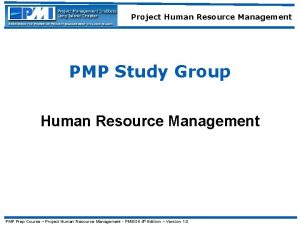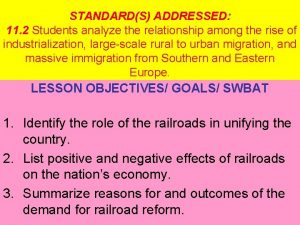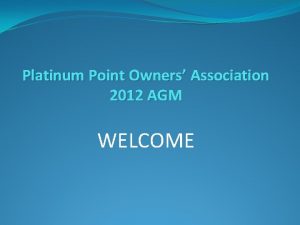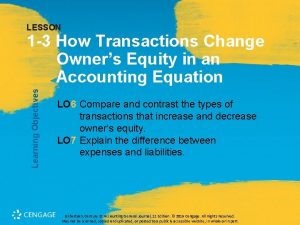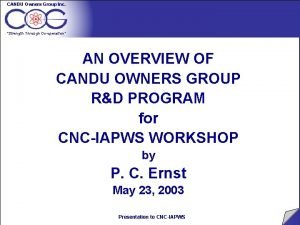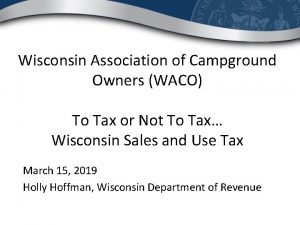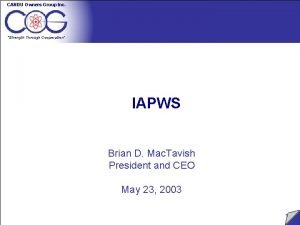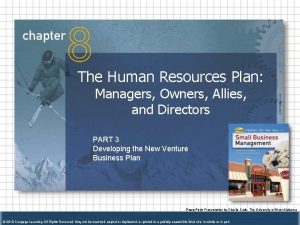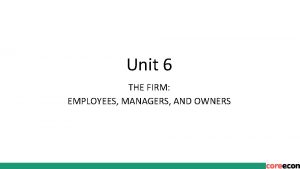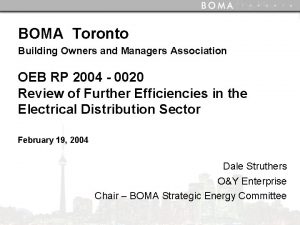The Human Resource Plan Managers Owners Allies and





























- Slides: 29

The Human Resource Plan: Managers, Owners, Allies, and Directors Part 3 Developing the New Venture Business Plan Power. Point Presentation by Charlie Cook The University of West Alabama Copyright © 2006 Thomson Business & Professional Publishing. All rights reserved.

Looking Ahead After studying this chapter, you should be able to: 1. Describe the characteristics and value of a strong management team. 2. Explain the common legal forms of organization used by small businesses. 3. Identify factors to consider in choosing among the primary legal forms of organization, including tax consequences. 4. Describe the unique features and restrictions of three specialized organizational forms: limited partnerships, S corporations, and limited liability companies. Copyright © 2006 Thomson Business & Professional Publishing. All rights reserved. 2

Looking Ahead (cont’d. ) 5. Explain the nature of strategic alliances and their uses in small businesses. 6. Describe the effective use of boards of directors and advisory councils. Copyright © 2006 Thomson Business & Professional Publishing. All rights reserved. 3

Building a Management Team • Management Team – Managers and other key persons who give a company its general direction • Characteristics of a Strong Management Team – Capable of securing the resources needed to make business a success – Reassures investors about their investment and the continuity of business – Diversity of talent makes the team stronger than an individual entrepreneur Copyright © 2006 Thomson Business & Professional Publishing. All rights reserved. 4

Building a Management Team (cont’d. ) • Team Building and Structure – The required combination of education and experience depends on the type of business and the nature of its operations. – The key is achieving a balance of skills and competencies in functional areas. – Design an internal management structure that defines relationships and responsibilities. • Outside professional support can supplement the skills of a management team. • An active board of directors can provide counsel and guidance. Copyright © 2006 Thomson Business & Professional Publishing. All rights reserved. 5

Legal Forms of Organization Exhibit 8. 1 Copyright © 2006 Thomson Business & Professional Publishing. All rights reserved. 6

Sole Proprietorship • Sole Proprietorship – A business owned by one person • Advantages – Receives all of the firm’s profits – Holds title to all of the firm’s assets – Can easily sell or transfer ownership of the company name and assets – Requires no registration or filing fee – Has absolute freedom from interference by other stakeholders Copyright © 2006 Thomson Business & Professional Publishing. All rights reserved. 7

Sole Proprietorship (cont’d. ) • Disadvantages – Bears all business risk – Is subject to all claims of creditors – Has unlimited personal liability for business – Receives no tax free benefits as an employee – Death/incapacity of owner terminates business – Is limited to the proprietor’s personal capital – Is taxed on business income as personal income Copyright © 2006 Thomson Business & Professional Publishing. All rights reserved. 8

The Partnership Option • Partnership – A legal entity formed by two or more co-owners to carry on a business for profit • Partner Qualifications – Required: Legal age to contract – Desired: Honest, healthy, capable, and compatible • Questions about Partnership Formation – What is our business concept? – How are we going to structure ownership? – Why do we need each other? – How do our lifestyles differ? Copyright © 2006 Thomson Business & Professional Publishing. All rights reserved. 9

Partnership Insights • Capitalize on the unique advantages of a partnership. • Choose your partner carefully. • Be open, but cautious, about partnerships with friends. • Test-drive the relationship, if possible. • Create a combined vision for the business. • Prepare for the worst. Copyright © 2006 Thomson Business & Professional Publishing. All rights reserved. 10

The Advantages and Disadvantages of Partnerships Advantages Disadvantages Sharing Workload Interpersonal Conflicts Sharing Emotional Burden Dissatisfaction with Partner Procuring Executive Talent Absence of One Clear Leader Sharing Financial Burden Dilution of Equity Companionship Frustration of Not Calling Own Shots Exhibit 8. 2 Copyright © 2006 Thomson Business & Professional Publishing. All rights reserved. 11

Rights and Duties of Partners • Partnership Agreement – A document that states explicitly the rights and duties of partners • Agency Power – The ability of any one partner to legally bind (e. g. , borrow money) the other partners Copyright © 2006 Thomson Business & Professional Publishing. All rights reserved. 12

The C Corporation Option • Corporation – A business organization that exists as a legal entity and provides limited liability for its owners • Legal Entity – A business organization that is recognized by the law as having a separate legal existence (“artificial being”); can be sued, hold property, incur debt • C Corporation – An ordinary, or regular, corporation chartered by the state and taxed by the federal government as a separate legal entity Copyright © 2006 Thomson Business & Professional Publishing. All rights reserved. 13

Corporate Charter: Articles of Incorporation • Name of company • Formal statement of formation • Voting privileges for each class of stock • Type of Business • Names of incorporators and directors • Location • Capital stockholders • Duration • Statement of limited liability for stockholders • Classes and preferences of stock • Number and par value of authorized shares • Statement of directors’ powers Copyright © 2006 Thomson Business & Professional Publishing. All rights reserved. 14

Rights and Legal Status of Stockholders • Stock Certificate – A document specifying the number of shares of stock owned by a shareholder • Pre-emptive Right – The right of current stockholders to buy new shares of stock before they are offered to the public • Legal Status – Ownership provides control over the firm – Ownership limits liability to investment in the firm – Ownership can be transferred without affecting the firm’s operations Copyright © 2006 Thomson Business & Professional Publishing. All rights reserved. 15

Comparison of Basic Legal Forms of Organization Form of Organization Initial Organizational Requirements and Costs Liability of Owners Attractiveness for Raising Capital Sole proprietorship Minimum requirements; generally no registration or filing fee Unlimited liability Limited to proprietor’s personal capital General partnership Minimum requirements; generally no registration or filing fee; written partnership agreement not legally required but strongly suggested Unlimited liability Limited to partner’s ability and desire to contribute capital Corporation Most expensive and greatest requirements; filing fees; compliance with state regulations for corporations Liability limited to investment in company Usually the most attractive form for raising capital Form of organization preferred Proprietorship or general partnership C corporation Copyright © 2006 Thomson Business & Professional Publishing. All rights reserved. Exhibit 8. 3 16

Choosing an Organizational Form • Factors that affect the choice of the firm’s structure: – Initial organizational costs and requirements – Limited versus unlimited liability for the owners – Continuity of business – Transferability of ownership – Management control – Attractiveness for raising equity capital – Income taxes Copyright © 2006 Thomson Business & Professional Publishing. All rights reserved. 17

Forms of Business—Federal Income Taxes • Sole Proprietorship – Self-employed persons are taxed on their business incomes at tax rates set for individuals. • Partnership – The partnership does not pay taxes; allocated shares of income from partnership are taxed as personal income for each of the partners. • Corporation – As a separate legal entity, it reports income and pays any taxes related to these profits. Copyright © 2006 Thomson Business & Professional Publishing. All rights reserved. 18

Forms of Business—Federal Income Tax Sole Proprietorship Example of taxes due from a married couple with $150, 000 in income from the business that they operate as selfemployed persons. Range of Taxable Income. Tax Rate $0–$14, 300 10% $14, 301–$58, 100 15% $58, 101–$117, 250 25% $117, 251–$178, 650 28% $178, 651–$319, 100 33% Over $319, 100 35% Income First $ 14, 300 Next $ 43, 800 Next $ 59, 150 Next $ 32, 750 Total $150, 000 Copyright © 2006 Thomson Business & Professional Publishing. All rights reserved. Tax Rate 10% 15% 28% Taxes $ 1, 430. 00 $ 6, 570. 00 $14, 787. 50 $ 9, 170. 00 $31, 957. 50 19

Forms of Business—Federal Income Tax Corporation Example of taxes due from the profits of a corporation. Any profits of the corporation that are distributed to the stockholders are taxed again as personal income. Range of Taxable Income $0 to $50, 000 $50, 001 to $75, 000 $75, 001 to $100, 000 $100, 001 to $335, 000 Tax Rate 15% 25% 34% 39% Income x Tax Rate= Taxes First $50, 000 15% $7, 500 Next $25, 000 25% $6, 250 Next $25, 000 34% $8, 500 Remaining $50, 000 39% $19, 500 Total $150, 000 $41, 750 Copyright © 2006 Thomson Business & Professional Publishing. All rights reserved. 20

Taxes on Gains and Losses • Ordinary Income – Income earned in the ordinary course of business, including any salary • Capital Gains and Losses – Gains and losses from sale of property that are not part of the firm’s regular business • Section 1244 Stock – Special of class stock that allows the owner to claim an ordinary income tax-deductible loss should the stock become worthless Copyright © 2006 Thomson Business & Professional Publishing. All rights reserved. 21

Specialized Forms of Organization • Limited Partnership Structure – General partner—active in the business, personally liable for the debts of the business – Limited partners—not active in the business, liability limited to investment in business – Income (taxable) or losses—apportioned to each partner Copyright © 2006 Thomson Business & Professional Publishing. All rights reserved. 22

Specialized Forms of Organization (cont’d. ) • S Corporation – Eligibility Requirements • No more than 75 stockholders • All stockholders must be individuals or trusts • Only one class of stock can be outstanding • Must be a domestic corporation • Must operate on a fiscal calendar year basis • No nonresident alien stockholders – Benefits • Liability limited to investment in corporation • Dividends avoid double taxation (corporate and personal income) Copyright © 2006 Thomson Business & Professional Publishing. All rights reserved. 23

Specialized Forms of Organization (cont’d. ) • Limited Liability Company – A corporation in which stockholders have limited liability but pay personal income taxes on the business profits • Easier to set up • More flexible • Tax advantages Copyright © 2006 Thomson Business & Professional Publishing. All rights reserved. 24

Forming Strategic Alliances • Strategic Alliances – An organizational relationship that links two or more independent business entities in a common endeavor – Benefits • Reduced cycle times through shared resources • Increased performance through synergistic combinations of financial resources and creativity – Risk • Difficulty in establishing and maintaining alliances Copyright © 2006 Thomson Business & Professional Publishing. All rights reserved. 25

Setting Up and Maintaining Successful Strategic Alliances • Steps in Building Strategic Alliances – Establish a healthy network of contacts. – Identify and contact individuals within a firm who are likely to return your call. – Outline the partner’s potential financial benefits from the alliance. – Learn to speak and understand the “language” of your partner. Copyright © 2006 Thomson Business & Professional Publishing. All rights reserved. 26

Making the Most of a Board of Directors • Board of Directors – The governing body of a corporation, elected by the stockholders – Inside directors • Board members who work for the firm – Outside directors • Board members who do not work for the firm • Duties – Elect the firm’s officers (top management) – Approve management’s plans and policies – Review performance and declare dividends Copyright © 2006 Thomson Business & Professional Publishing. All rights reserved. 27

The Board of Directors (cont’d. ) • Contributions of Board of Directors – Bring knowledge and experience • Review policy decisions • Provide general direction • Monitor the firm’s ethical behavior • Mediate and resolve disputes among top management • Alternative: Advisory Council – Provides advice but does not have the fiduciary responsibility for the direction of the firm Copyright © 2006 Thomson Business & Professional Publishing. All rights reserved. 28

Key Terms management team ordinary income sole proprietorship capital gains and losses unlimited liability Section 1244 stock partnership limited partnership agreement general partner agency power limited partner corporation S corporation (Subchapter S corporation) legal entity C corporation corporate charter stock certificate pre-emptive right limited liability company strategic alliance board of directors advisory council Copyright © 2006 Thomson Business & Professional Publishing. All rights reserved. 29
 Guided reading wilson fights for peace
Guided reading wilson fights for peace Meaning of human resource planning
Meaning of human resource planning Skill inventory in human resource planning
Skill inventory in human resource planning Bureau of human resource and organizational development
Bureau of human resource and organizational development What are physical resources
What are physical resources Sample of human resource development plan for teachers
Sample of human resource development plan for teachers Shrek ordinary world
Shrek ordinary world Ferns and fern allies
Ferns and fern allies Resource allocation vs resource leveling
Resource allocation vs resource leveling Perbedaan resource loading dan resource levelling
Perbedaan resource loading dan resource levelling How did railroad owners use credit mobilier
How did railroad owners use credit mobilier Owners plural possessive
Owners plural possessive Platinum point owners forum
Platinum point owners forum Changes in owners equity
Changes in owners equity Owners equity meaning
Owners equity meaning Accounting in action
Accounting in action Bridge owners forum
Bridge owners forum Activating students as owners of their own learning
Activating students as owners of their own learning Www.wo
Www.wo Candu owners group
Candu owners group The owners of a small manufacturing concern have hired
The owners of a small manufacturing concern have hired Wisconsin association of campground owners
Wisconsin association of campground owners Rights of business owners
Rights of business owners Platinum point owners association
Platinum point owners association House slaves vs field slaves
House slaves vs field slaves The harley owners group (hog) is an example of a ______.
The harley owners group (hog) is an example of a ______. Arbitration apush
Arbitration apush Brian mac muscular endurance
Brian mac muscular endurance Wealthy merchants factory owners shippers
Wealthy merchants factory owners shippers Lesson 4 the allies turn the tide
Lesson 4 the allies turn the tide




